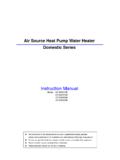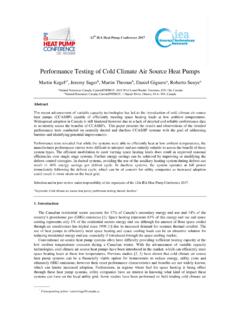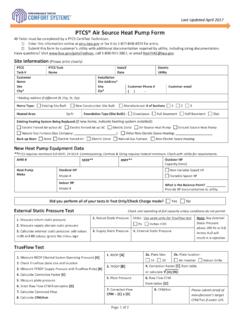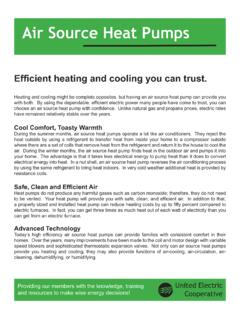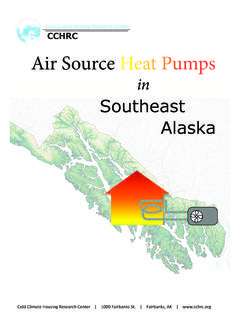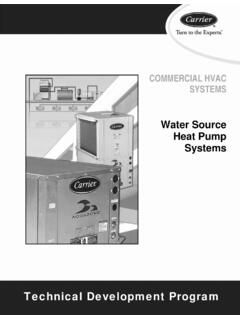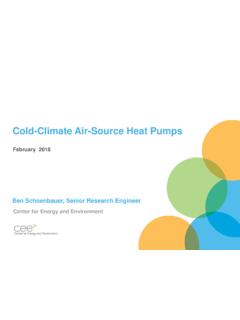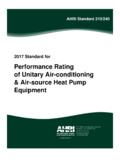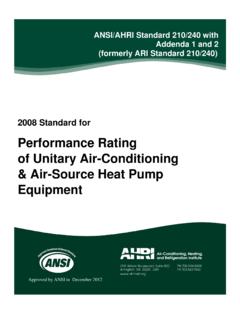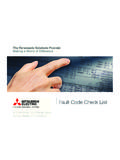Transcription of Good practice guide - Amazon Web Services
1 good practice guideHeat pump installationInspiring energy efficiency advancing renewable energyGood practice guide to heat pump installationIndex of figures and tables Introduction heat pump systems 8 Types of heat pump systems 8 Components of a heat pump 10 How a heat pump works 12 Fixed-speed and inverter compressors heat pump performance 13 heat pump efficiency 13 Energy rating label 14 Effects of temperature on efficiency 14 Impacts of defrost cycle on efficiency Designing a heat pump system 16 Steps for designing a heat pump system 16 The importance of correct heat pump sizing 16 Step 1: Determine requirements 17 Step 2: Determine design temperature 19 Step 3: Calculate heat load requirement 20 Step 4: Select a system to meet requirements 22 Step 5.
2 Locate the units Toolkit Installing pipework 27 Pipework installation 27 Pipework pre-installation in new buildings heat pump installation 34 Pre-installation checklist 34 Installing the indoor unit 35 Installing the outdoor unit 38 Connecting piping to indoor and outdoor units 40 Leak/pressure test 42 Evacuation of the system Refrigerants 45 Refrigerant charging 46 Labelling as record of service Electrical requirements 47 Installing electrical wiring 47 Outdoor unit connections 47 Nameplate Testing, commissioning and customer operating instructions 49 Pre-commissioning checks 49 Electrical checks 49 Prepare the remote control 49 Testing the new system 50 Instructions to the owner 50 Quality assurance checklist for auditing Servicing and maintenance 54 Owner maintenance 54 Service person maintenance Case studies 56 Case 1 Auckland 57 Case 2 Wellington 59 Case 3 Dunedin 614 Figure Split system heat pump 8 Figure Multi-split system heat pump 8 Figure Ducted heat pump system 8 Figure High wall-mounted unit 9 Figure Ceiling cassette 9 Figure Floor console 9 Table
3 heat pump components 10 Figure Schematic diagram of reverse-cycle, air-to-air, split system heat pump operation (heating mode) 10 Figure Schematic diagram of reverse-cycle, air-to-air, split system heat pump operation (cooling mode) 11 Figure Schematic diagram of heat pump operation (heating) 11 Figure Fixed-speed compressor operation 12 Figure Inverter operation 12 Figure Schematic of heat pump performance 13 Figure New energy rating label from October 2009 for heat pumps / air conditioners 14 Figure ENERGY STAR mark 14 Figure Graphic representation of heat pump efficiency 14 Table Outdoor ambient temperature rating conditions 15 Table Designing a heat pump system 16 Table Effects of incorrectly sized systems 16 Figure Floor-mounted unit horizontal and vertical air discharge (heating) 18 Figure Ceiling-mounted unit horizontal air discharge (heating)
4 18 Figure Ceiling-mounted unit vertical air discharge (heating) 18 Figure Wall/high wall-mounted unit horizontal air discharge (cooling) 18 Figure New Zealand climate zones (design temperature in C) 19 Table Simple guide to determine heat load requirement 20 Table Heater sizer 21 Table Example of a heat pump performance guide chart 22 Figure Outdoor unit clearances 23 Figure Service access 23 Figure Exchange cylinders, adequately ventilated, in storage or in use. 23 Figure Locate the outdoor unit where a solid barrier can block the sound 24 Figure Wall-mounted indoor unit clearances 24 Figure Pre-install pipework before building claddings are installed 25 Figure Permitted notching and drilling of timber framing allowed under NZS 3604 25 Figure Twin-insulated and dehydrated pipe 27 Figure Pipe opening facing down when cutting 28 Figure Cover pipe ends 28 Figure Pipe bender 28 Figure Cut pipe with tube cutters 29 Figure Remove all burrs 29 Figure Place the flare nut over the pipe end 29 Figure Flare the end of the tube (A)
5 29 Figure Flare the end of the tube (B) 29 Figure Flare the end of the tube (C) 29 Figure Flare the end of the tube (D) 30 Figure Apply oil to the back of the flared pipe and the flare joint 30 Figure Connect the pipes (A) 30 Figure Connect the pipes (B) 30 Index of figures and tablesGood practice guide to heat pump installation5 Figure Tighten connection (A) 30 Figure Tighten connection (B) 30 Table Fixing spacings for copper tubing 31 Figure Run pipe/cable across truss chord/ceiling joist 32 Figure Notch the top plate and studs (A) 32 Figure Notch the top plate and studs (B) 32 Figure Fix galvanised mild steel strap to hold pipe/cable 33 Figure Wedge the pipe cable end into the stud 33 Figure Braze pipe ends closed 33 Figure Fix galvanised mild steel strap to hold pipe/connection cable 33 Figure Feed pipe/cables through building wrap 33 Figure Seal pipes or sleeve 33 Figure Maximum pipe length and height 35 Figure Screw-fix installation plate 35 Figure Drill a hole through the wall 36 Figure Slope of wall penetration 36 Figure Release the tubing and drainage hose 36 Figure Feed the connecting cable through the wall 36 Figure Tape tubing.
6 Drainage pipe and connecting cable together 36 Figure Feed taped bundle through the hole 36 Figure Attach unit to wall bracket (A) 37 Figure Attach unit to wall bracket (B) 37 Figure Ensure unit is securely seated 37 Figure Taped pipes, drainage pipe and connection cable through hole 37 Figure Expose flared pipe ends 37 Figure Unobstructed gap under outdoor unit fixed on concrete pad cast in place 38 Figure Concrete pad construction 38 Figure Fixing unit to a timber deck 39 Figure Pack with plastic shims to level 39 Figure Wall-mounted unit on brackets masonry wall 39 Figure Bind insulation with vinyl tape 40 Figure Tape drainage hose to drainage outlet 40 Figure Install trunking neatly 41 Figure Fit refrigerant piping.
7 Drainage pipe and connecting cable into trunking 41 Figure Fill hole around piping with sealant 41 Figure Seal around cover 41 Figure Fit cover over opening 41 Figure Apply oil to the back of the flare and the outdoor unit 42 Figure Connect pipes and tighten flare nut 42 Figure Tighten flare nut connections 42 Figure Remove vacuum pump and gauges (A) 43 Figure Remove vacuum pump and gauges (B) 43 Figure Remove vacuum pump and gauges (C) 44 Figure Progressively release the vacuum 44 Figure Tighten valve caps 44 Table Single step, deep vacuum method 44 Table Triple evacuation method 44 Figure Connect power supply cable to terminal block 47 Figure Install lockable isolating switch (A) 47 Figure Install lockable isolating switch (B) 48 Figure Install lockable isolating switch (C)
8 48 Figure Replace service cover to outdoor unit 48 Figure Annual heat pump running costs 51 Figure House plan used in case studies 56 Figure House elevations A and B as used in case studies 56 Figure House elevations C and D as used in case studies 56 good practice guide to heat pump IntroductionHeat pumps have become increasingly popular in New Zealand homes over recent years as they are an energy efficient and convenient way of heating and cooling. By using a relatively small amount of electricity, a heat pump can extract heat energy from one location typically outdoor air and transfer it to another location to provide heating.
9 The reverse process can provide design and installation are fundamental to a heat pump system s effectiveness and efficiency. It involves understanding the importance of correct sizing for the ambient conditions, selecting the right unit for the local environment and correctly installing the guide provides good practice guidelines for designing and installing the most common type of residential heat pump system air-to-air single-split heat pump systems (also known as reverse-cycle air conditioners), used primarily for heating. The guide is aimed at experienced installers of heat pumps , and it gives the process to follow for system design and installation into both new and existing that this guide does not cover: multi-split or ducted heat pump systems ground-to-air, water-to-air or water heating systems DIY installations EECA recommends heat pump systems are installed by experienced installers weathertightness and airtightness of the building envelope and structural integrity (though this must be maintained).
10 Before you beginInsulate firstThe first consideration for a house holder when installing a heat pump system into any home is reducing heat loss as much as possible by: adding ceiling and underfloor insulation where practicable adding weather stripping to doors and windows eliminating you are qualified and preparedThe installation of any heat pump system should be carried out by suitably qualified installers who: have the correct toolkit to allow them to carry out the work are licensed to carry out the electrical work hold a no-loss certification for the handling of refrigerants. Know your standards and regulationsStandards and regulations applicable to a heat pump installation that must be complied with include the following: Building Co

